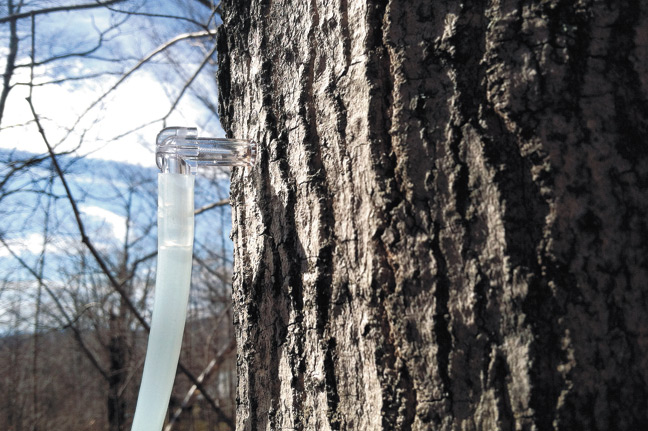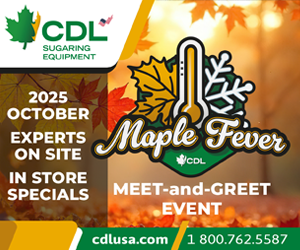UVM Proctor Page
Proctor comes out with long awaited new tapping guidelines
By BY ABBY VAN DEN BERG, TIMOTHY PERKINS, TIMOTHY WILMOT, AND MARK ISSELHARDT |
Each year, tapping for sap collection permanently removes a small portion of wood where the spout is inserted. The tree’s response to the wound also results in a column of wood extending above and below the taphole that remains permanently nonfunctional for water transport and future sap collection. Sap collection also removes a portion of the tree’s carbohydrate (sugar) reserves, which are important for supporting the tree’s growth and health.
For annual maple sap collection to be sustainable, the volume of nonconductive wood generated by tapping shouldn’t exceed the volume that can be replaced by annual diameter growth. Also, the portion of sugar reserves extracted should not be large enough to reduce growth rates and hinder the replenishment of functional wood. Tapping guidelines are a set of best practices aimed at ensuring these conditions are met, and that tree health is not compromised as a result of sap extraction.
Many of the existing tapping guidelines were developed when collecting sap in buckets under gravity conditions was the predominant practice. They were also aimed mainly at mitigating the impacts of the wound caused by tapping, and did not account for the effects of removing a portion of the tree’s carbohydrate reserves. Since then, better vacuum pumps, tubing system materials and design, and tubing/spout replacement and sanitation strategies have led to significant increases in the amount of sap collected from tapholes. For these reasons, it is essential to determine whether existing tapping guidelines are appropriate to use with these current, “high yield” sap collection practices which remove a much greater amount of a tree’s sap.
Methods
We evaluated whether existing conservative tapping guidelines are appropriate and likely to result in sustainable outcomes when used with sap collection practices that result in higher sap yields. For a more complete description of the evaluation process, see the full research report at http://nsrcforest.org/project/sustainable-tapping-guidelines-modern-maple-syrup-production.
Briefly, we first conducted research to determine the diameter growth rates of trees tapped with high yield sap collection practices. Increment cores were collected from about 800 sugar maple trees that had been tapped for at least 5 years with these practices and a single tap, from 18 stands in VT with good site quality for maple growth. (For this project, we defined high yield practices as having vacuum levels ≥20” Hg and/or yields of ≥0.4 gallons of syrup equivalent per tap.) Selected stands had not been thinned or experienced significant stress events in at least the past 10 years. The selected trees at each site were healthy, had dominant or codominant position in the canopy, and represented the full diameter range (12-18” dbh) tapped with a single tap under current conservative tapping guidelines (outlined in the 2006 North American Maple Syrup Producers Manual1). We measured the growth rings of each core and used these data to calculate the average growth rates of trees in several diameter classes at each site, and then the overall average growth rates of trees in each diameter class.
We then developed a model that estimates the amount of conductive wood in the tapping zone of a tree over time, and the model was used to calculate the minimum diameter growth rates required for tapping to be sustainable when using the conservative tapping guidelines.1 Sustainability was defined as maintaining a large proportion of conductive wood in the tapping zone, ≥90%, for at least 100 years.
(This equates to a probability of hitting white, clear wood when tapping in about 9 out of every 10 trees, and was chosen after consultation with producers and maple extension personnel.) We compared these 2 minimum rates to the growth rates of the trees sampled in our research, to see if the average growth rates of trees tapped with high yield practices generally exceeded the minimum rates required for tapping to be sustainable.
Results and Recommendations
We found that the growth rates of sampled trees typically exceeded the minimum rates required when following the existing conservative tapping guidelines outlined in the North American Maple Producers Manual.1 This indicates that, in general, for healthy trees that have dominant or codominant canopy position and are growing on good quality sites, current conservative tapping guidelines are generally appropriate to use when tapping with high yield sap collection practices.
It is important to note that this recommendation applies only to healthy trees with dominant or codominant canopy position growing on sites that are generally of good quality for sugar maple growth, and only when all best practices specified in the tapping guidelines are followed.1 The complete description of best tapping practices outlined in the Manual should be consulted, but they include these basic guidelines:
Minimum tree diameter (at breast height) = 12 inches
Minimum dropline length = 30 inches
Maximum tapping depth = 1.5 inches
Spout Size = 5/16 or 19/64 inches
The recommendations based on our research do not apply to trees that have suppressed or intermediate canopy position, or those that are growing on poor quality sites. They are also not applicable to trees that are slow-growing, less healthy, or show signs of stress or disease (poor crown condition, smaller or fewer leaves than normal, slow-healing wounds, major trunk wounds, branch dieback, etc). Tapping practices should be modified if any of these conditions is present. Caution should also be used in stands that are very dense, as even healthy trees in dense stands can have very slow rates of diameter growth.
Tips for evaluating the site quality of your stands can be found in the North American Maple Producers Manual, and in the following article: http://www.uvm.edu/~pmrc/fertilization_brochure.pdf.
Though the recommendations outlined are generally applicable to the types of trees and stands indicated, it is important to remember that the only way to truly know whether tapping following these guidelines will be appropriate for your trees is to determine their growth rates. Your county or a consulting forester can provide assistance with assessing the growth rates of your trees.
A few other notes:
ν 1.5” is the middle of the tapping depth range specified by the guidelines. For very healthy trees with good growth rates, it may be acceptable to tap to a depth of 2”. (UVM Maple Extension Specialist Tim Wilmot is currently conducting a study to determine the tapping depth which optimizes sap yield while considering the damage generated by the taphole, and we will update these recommendations as needed upon the conclusion of that research. For more information about tapping depth, see the following article by Tim: http://www.uvm.edu/~pmrc/wilmot_deep.pdf)
ν The length of droplines strongly influences the total area of the trunk available to tap, so shorter droplines can rapidly result in nonconductive wood making up a large proportion of the tapping zone. 30” should be considered a minimum length, and longer droplines, ~36”, are recommended. Also, if your practices include annual or periodic spout replacement, remember to factor this in when making your droplines – a few years of cutting spouts off droplines for replacement can quickly turn your 30” droplines into 20” droplines, and greatly reduce the sustainability of your tapping practices!
ν A webtool based on the model developed by this project will soon be available on the UVM-PMRC website. It will allow you to input parameters such as tapping depth and dropline length to predict the sustainability of tapping practices.
Smaller trees
Some other tapping guidelines specify that trees smaller than 12” in diameter can be tapped. For example, the “Traditional” tapping guidelines outlined in the Manual specify 10” as a minimum diameter,1 and the Vermont organic (NOFA-VT) guidelines specify 9” as a minimum.2 Results from our study indicate that tapping trees in the 10-12” size class will generally be sustainable, so long as the criteria outlined above are met and followed (canopy position, health, site quality, tapping practices, etc.).
Trees smaller than 10” dbh should be tapped very cautiously – trees this small rapidly accumulate large amounts of nonconductive wood in the tapping zone, and sap collection removes a much greater proportion of their carbohydrate reserves than in larger trees. Also, something that we encountered during our research is that tapped trees in this dbh range often had suppressed or intermediate canopy positions. These trees had much slower growth rates, and would thus accumulate nonconductive wood even more rapidly. Optimally, growth rates of small trees should be determined before tapping, and should exceed a basal area increment of 1.1 in2/yr. For more information about tree diameter growth, please see the following article by Tim Wilmot: http://www.uvm.edu/~pmrc/wilmot_diameter.pdf.
Adding a second tap
The conservative tapping guidelines we’ve referred to1 specify that a second tap can be added in trees greater than 18” in diameter. This is likely an acceptable practice for trees tapped with high yield collection practices, however caution should be used when deciding which trees will receive a second tap. Our research examined only the growth rates of trees that were tapped with a single tap, and results from trials with the model suggest that putting a second tap in less vigorously growing trees can result in a proportion of damaged wood in the tapping zone greater than 10% after only a few years of tapping.
For this reason, we recommend putting a second tap only in very healthy trees with excellent growth rates. If you begin hitting discolored wood (brown, non-white) more frequently after adding a second tap, you should consider reducing tapping intensity.
References
1) Chapeskie, D., Wilmot, T.R., Chabot, B. and Perkins, T.D. 2006. Maple sap production –tapping, collection, and storage. In North American Maple Syrup Producers Manual (R.B. Heiligmann, M.R. Koelling, T.D. Perkins, Eds.) pp 81-116. The Ohio State University, Columbus, OH.
2) Northeast Organic Farming Association of Vermont (NOFA-VT). 2012. VOF Organic Maple Sap and Syrup Production
Guidelines. http://nofavt.org/sites/default/files/2013%20VOF%20Maple%20Guidelines.pdf
This project was supported by the Northeastern States Research Cooperative through funding made available by the USDA Forest Service. The conclusions and opinions in this paper are those of the authors and not of the NSRC, the Forest Service, or the USDA.
November 2013
































